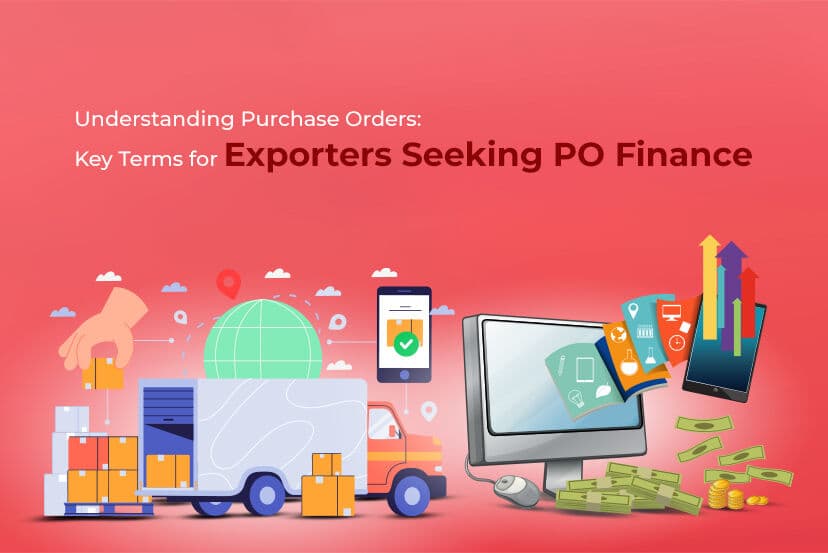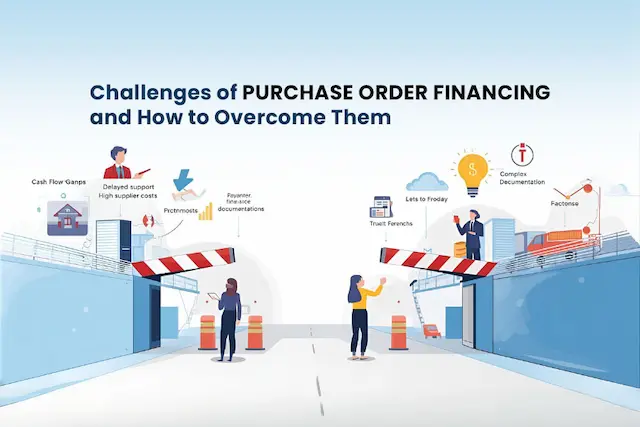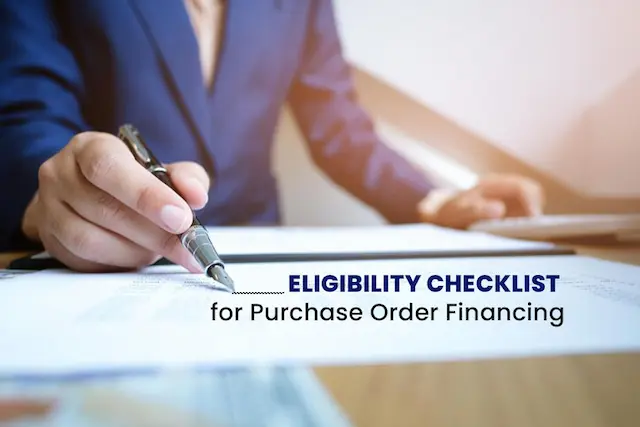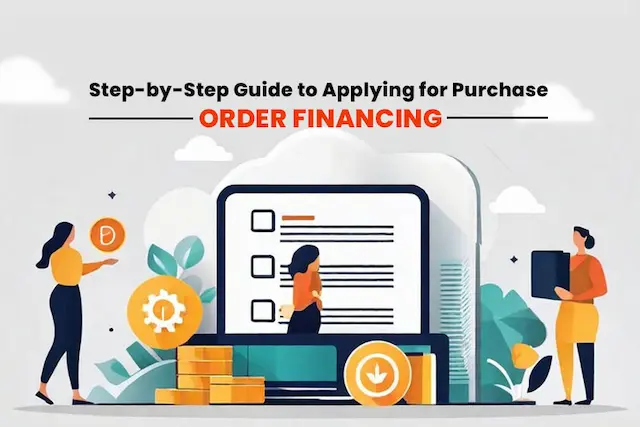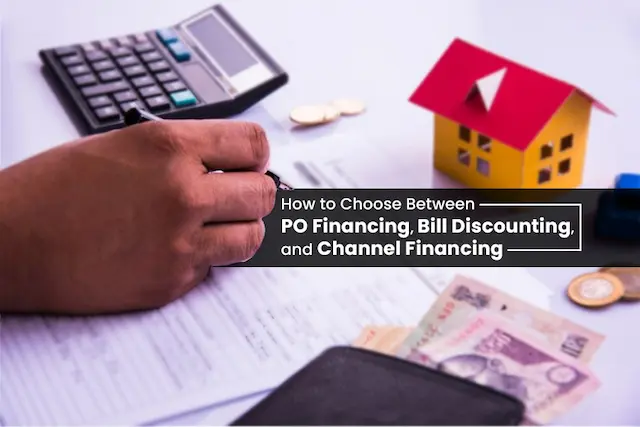Indian exporters depend on purchase orders (POs) to get major contracts, preserve trust with buyers from different countries, and get the necessary funds. There are still cases where SMEs do not have a clear picture of the specifics of a PO and how these impact the eligibility of purchase order financing. Being aware of what purchase orders mean and entail is important, no matter if you handle them for the first time or are just stepping up your exports.
What Is The Role Of A Purchase Order In The Process Of Exporting
An order for purchases is presented by a buyer to the seller; such an order specifies the type, quantity, and price of products or services that the buyer is contracting to purchase. In the market for international trade, it is seen as a guarantee provided by foreign buyers so that production or shipment can proceed.
By presenting a well-organised PO, an exporter may be eligible for pre-shipment financing due to the better transparency and confidence in the transaction.
Key Elements of a Valid Purchase Order
You can only apply for PO finance if your purchase order is well-written, genuine, and complete. Usually, financial institutions and companies in fintech expect several essential things from applicants.
- Information about who the buyer or seller is
- Providing the details of a product and its key features
- Quantity and the price sold per piece
- Duration and schedule of the delivery
- Ways of payment and the time allowed for payment
- Point of Origin (PO) number and the date
Preparing a detailed PO reduces the possibility of facing problems or disputes in the future.
Commercial Invoice vs. Purchase Order
Some exporters confuse the commercial invoice with a purchase order, which are two completely different documents. Once items are ordered, the buyer issues a purchase order, and after sending the items, the seller issues the commercial invoice.
Most decisions in purchase order financing are based on the PO, since it is more important than invoices in this context. Before giving money, lenders will ask for confirmation that the buyer has made a confirmed order and is ready to pay.
Payment Terms That Affect Financing
The way you pay for your purchase order can impact the financial support you can get. Exporters need to know about certain important terms like:
- Advance Payment – The seller gets the money upfront, and usually, there is no need to secure financing.
- Letter of Credit (LC) – Banks promise they will handle and approve the payment
- Net 30/60/90 – Buyer is expected to make the payment 30, 60, or 90 days after the order is delivered.
- Cash Against Documents – Buyer pays when documents for the shipment are issued to them.
When the payment deadline is Net 60 or 90 days, exporters may need working capital since they have to cover the funds for a longer period before being paid.
Incoterms and Their Impact
Incoterms define who pays for the delivery, protection, and handling of goods at the border. FOB, CIF, and DDP are some of the terms merchants commonly use.
Arrangements for financing become clearer with the knowledge of Incoterms. According to FOB terms, the exporter transfers the risk at the port, which is an important point for financiers. Understanding these terms enables exporters to handle their transactions more successfully and prevent surprises.
Proof of Order Authenticity
Lenders check the buyer’s credibility and confirm the PO’s authenticity before they approve the finance. The following factors ensure reliability-
- An official sign or digital signing information
- The company’s letterhead is used when you write the purchase order.
- The process of communication between the buyer and seller
- An agreement or contract for export deals
Documentation verification is a key component when conducting risk assessment in PO financing.
Supplier Information and Role
For a lot of export companies, working with suppliers or manufacturers is very important. For large orders, when third-party vendors are needed by your business, their details may be checked during the application.
Thanks to supplier due diligence, lenders can find out if your company’s supply chain can fulfil the buyer’s requests on time.
Fulfilment Timeline and Its Financing Implications
The date for delivery in the PO guides the actions of financiers when they provide funds. Having a shorter fulfilment period means money could be disbursed more rapidly; in contrast, a longer period might need the investment distributed in moves or at major checkpoints.
If you link your funding timeline with the schedules for production and deliveries, receiving funds will become simpler.
Creditworthiness of Buyer
Whether you will get an approval for PO funding depends on the creditworthiness of your overseas buyer. Most lenders in the fintech field either develop their tools or use external trade databases to check if a buyer is risky.
Those who cooperate with leading foreign partners receive quicker permission and favorable financial offers. Tracking how your buyers pay you can assist in having a sound credit profile.
Currency and Tax Information
Most often, export POs make sure to mention the currency to be used for the transaction, as well as any taxes or duties. It allows the company to decide on the price for the invoice and the amount of money to be given out.
When markets are not stable, currency risk can cause problems. Given the changing exchange rate, some lenders make calculations accordingly when giving out loans to exporters.
Get Ahead by Mastering the Basics
Exporters who wish to get financial assistance from an export credit agency must understand the key terms in purchase orders. No matter if the order is from a Mexican buyer or a European textile supplier, a precise PO promotes trust and allows companies to use PO financing in their supply chain.
Learning key skills and joining hands with the proper fintech provider allows Indian exporters to operate smoothly around the world and deal with cash flow issues without hassles.
SMEs in India needing help to turn confirmed orders into cash rely on Credlix’s smooth solutions. Credlix’s purchase order financing makes it possible for traders to boost their export sales without having to pay for production upfront. Textiles, food, and light manufacturing companies using Credlix enjoy a quick digital registration, clear pricing, and access to up to 90% of their purchase orders. The process also reduces the risk for buyers and helps pay suppliers, which allows exporters to concentrate on getting products to clients on time.
